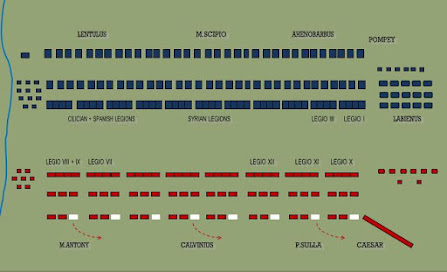THE BATTLE OF PHARSALUS 48 BC
The Roman civil war between Julius Caesar and the Senate had broken out early in 49 AD when Caesar crossed the River Rubicon and marched on Rome. Pompey the Great decided to fight for the Senate but his Legions were dispersed throughout the Republic and it would take time to assemble them into an army. Pompey therefore abandoned Italy and regrouped to the east.
In January 48 AD Caesar crossed the Adriatic Sea with seven Legions and landed in modern day Albania. For the next six months both he and Pompey built large fortresses facing one another at Dyrrhachium.
On July 10 Caesar was defeated by Pompey at the Battle of Dyrrhacium and forced to march further inland with his remaining forces to Greece. On August 9 Pompey's larger army caught up with Caesar and blocked his path at Pharsalus.
Upon closer inspection Caesar had observed that Pompey's left wing comprised two Legions, the 1st and 3rd under Pompey's direct command. The Legions of Syria were placed in the center under Pompey's father in law Quintus Scipio and his right wing was made up of the Legions of Spain under General Leniulus.
Pompey's right wing was also firmly secured by a river with steep banks. Therefore he placed all his cavalry 6,000 strong on his left wing under the able command of General Titus Labienus. In all Pompey's army amounted to 45,000 men.
Caesar placed his veteran 10th legion on his right, the 9th on the left and the 8th in the center. Caesar then placed Marc Antony in command of the left, Publius Sulla with himself on the right and Gnaeus Calvinus in the center. Caesar then placed all his cavalry 2,000 horseman opposite Labienus, in all some 22,000 men. It was Caesar who began the battle ordering his men to advance, when Pompey's forces came within range, Caesar's Legions released there javelins and then drew swords. Pompey's men received the javelins, stood firm and maintained their ranks, then having launched their own javelins, had the recourse to draw their swords.
As the two Roman armies became heavily engaged, Labienus charged forward against Caesar's cavalry. After fierce fighting Pompey's horsemen slowly began to gain the advantage and where close to flanking Caeser's army.
At this critical point in the battle, Caesar gave the signal for the six reserve cohorts he had stationed to the rear of his cavalry behind a reverse slope to make thier presence known and advance to Sulla's aid.
Unawares, the Legionaires hit Labienus's cavalry in the flank. Startled by the arrival of fresh Infantry, the Republican cavalry turned about, deserted the field and galloped to the safety of the mountains. The Cohorts, continuing to advance, wheeled upon Pompey's exposed left wing and now attacked them in the rear.
Pompey's flank was now quickly disintegrating, his cavalry had been routed and his center formations were not able to maintain their ground. The Republican army soon lost zeal for the fight and began fleeing into the mountains en mass.
Caesar now pursued Pompey to his main camp, Pompey then quickly mounted his horse and hastily fled out the back gate towards Larissa and then to the sea where he and the last of his Centurians boarded a barge and headed for Egypt.
The battle of Pharsalus was now over, Pompey's army suffered 15,000 dead and 24,000 taken prisoner. Nine Eagles and one hundred and fifty color standards were presented to Caesar. Pompey inflicted a mere 1,000 dead and 2,000 wounded upon Caesar.




No comments:
Post a Comment
Note: Only a member of this blog may post a comment.